An Overview of Ramakrishna Movement in Punjab and Haryana
(Continued from the previous issue. . .)
Ramakrishna Mission Centres in the Punjab Region
Ramakrishna Mission was founded in 1897 by Swami Vivekananda and ever since it has been carrying on its activities according to the twofold ideal which Swamiji placed before it: atmano mokshartham Jagad hitaya cha, ‘For one’s own liberation and for the welfare of others.’ Service and spirituality is the main motto. The Math and Mission together have nearly 200 centres—150 across India and others in Bangladesh, Nepal, Malaysia, Singapore, United Kingdom, Germany, United States of America and some other countries.
While discussing the Ramakrishna Movement in Punjab and Haryana, it is contextually necessary to know how the movement came into existence in these provinces. We have already stated the visits of Swami Vivekananda and some of the direct disciples of Sri Ramakrishna to Undivided Punjab.
Relief Work in 1947-48: : In the wake of the massive migration from the just-formed Pakistan to India, a large number of Hindus and Sikhs were accommodated by the Government in a make-shift colony of tents in Kurukshetra in today’s Haryana. The Ramakrishna Mission started large-scale relief work for assuaging their pain and helpless condition. The main requirement of the refugees which the Mission tried to address was the medical needs of refugees and supply of milk to them. A free milk canteen and two dispensaries were started under the supervision of monks and volunteers of the Ramakrishna Mission, a work that continued for months. The Mission also helped the Government of India in the distribution of clothes. Lady Mountbatten, who visited our Camp, wrote a letter of appreciation for the Mission’s relief work.19
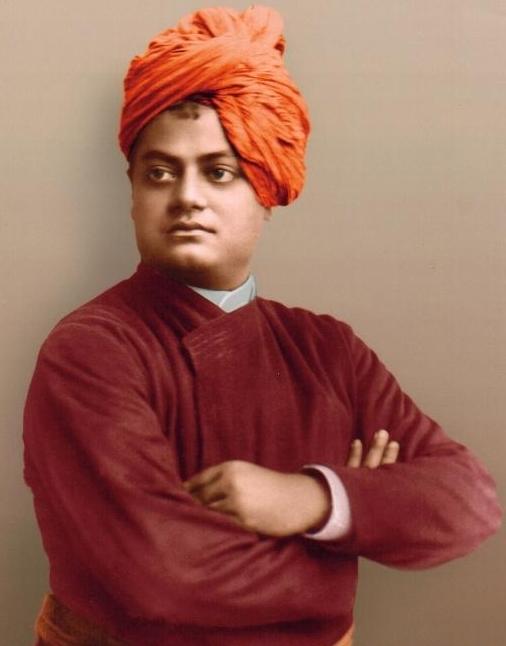
The Lahore Centre
As we survey and document the Ramakrishna Movement in Punjab and Haryana, we should remember that before partition of India in 1947, Lahore was the cultural and economic epicenter of the Undivided Punjab. The Ramakrishna Mission had a branch in Lahore for over ten years, but it was closed in 1947. Prior to Lahore centre, the Ramakrishna Mission opened a centre in Karachi which in fact had a greater influence on the local populace thanks to the head of the centre, Swami Ranganathananda, later the 13th President of the Ramakrishna Math and Ramakrishna Mission. The Karachi centre drew many eminent people of the city and became a flourishing place of preaching, service and pure living. In 1936 it celebrated the birth centenary of Sri Ramakrishna, with the main function presided over by Swami Madhavananda, later the 9th President of the Ramakrishna Order.
Prior to the opening of the official centre in Lahore, a ‘private’ centre was started in 1916 by a group of devotees who conducted some medical services and discourses. In 1919, as a report in the Vedanta Kesari shows, they ‘celebrated the birth-day of Swami Vivekananda under the auspices of Ramakrishna Sevashram, Lahore, in the compound of Bhai Nand Gopal’s temple. … Swami Sevananda read out his report of the work of the local Ashrama for the year 1918. The report gave an idea of the good work done by the Ashrama which was established in Lahore on the 17th April 1916, for administering medicines to the sick, of helping the famished stomachs with food and provisions, and of relieving the distress caused by epidemics.’
The first official centre of the Ramakrishna Mission, however, was opened in Lahore in 1936. At the request of some local devotees interested in the ideals and activities of the Ramakrishna Mission, the Governing Body of the Mission decided to open a branch at Lahore at the beginning of the year, and deputed Swami Adyananda for the purpose. The formal opening of the Centre took place on the 21 February 1939—the birthday of Sri Ramakrishna. There was Puja, Homa and Path (chanting of the scripture) at the rented house. In the evening a public meeting was held at the Sanatan Dharam College Hall. The Hon’ble Justice Mr. M. V. Bhide presided. There was a good gathering and prominent ladies and gentlemen attended. Swami Adyananda, Sir Gokul Chand Narang, Prof. S. N. Das Gupta, Principal T. N. Maulick, Dr. T. N. Sita Ram, Prof. Hiralal Chopra and Prof. Teja Singh addressed the meeting on the ideas, ideals and activities of the Mission in different parts of the world.
The Ashrama was started in a rented house at 3A, Lodge Road, Lahore. To begin with it conducted classes and occasional lectures on Vedanta as lived and taught by Sri Ramakrishna. The local public gave an enthusiastic response to it. It was first located at 16/2, and later at 16/1, Lodge Road. It slowly began to conduct an outdoor dispensary, a library, religious classes and occasional lectures outside. The centre also collected and sent to the Headquarters over Rs. 6,000/- towards Bengal Distress Relief—which was quite a large amount in those days!
But in August 1947, owing to the violent outbreak of communal disturbances in the city and the province immediately after the partition of the country, the Swami in-charge and his assistants had to quit the premises leaving everything behind. Thus the activities of the centre came to a close.
Ramakrishna Mission in Chandigarh
While both the centres (Karachi and Lahore) had to be closed in the wake of the Partition of India and the subsequent violence and prevailing tense atmosphere, Ramakrishna Mission in Lahore was sought to be revived at the newly under-construction capital of Punjab, Chandigarh. Swami Adyananda, the monk who headed the Lahore Centre, shifted to India, carrying with him a number of books from the Ramakrishna Mission, Lahore. A good number of these books (with the stamp of ‘Ramakrishna Mission, Lahore’ on them) are even now part of the small public library maintained by Ramakrishna Mission in Chandigarh.
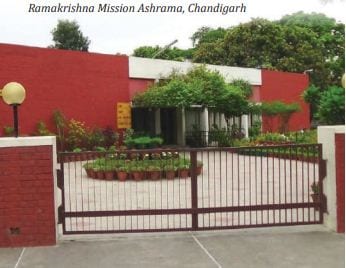
Ramakrishna Mission in Chandigarh was started in November 1956 in a rented house in Sector-9C and then moved to Sector-16D. In 1955, the Punjab Government allotted a plot of about three acres of land to the Mission at a concessional price in the well-situated Madhya Marg in its Sector 15-B, in the cultural zone near colleges and Panjab University. Swami Adyananda raised funds for the construction of the Ashrama buildings. After his demise in September 1957, Swami Vedananda took over and the Centre was moved to another rented house near the plot in Sector-15 B to facilitate supervision of construction work. The Governor of Punjab, Shri C. P. N. Singh, laid the foundation of the Ashrama in 1957. The next year, a small building was partly constructed and the Ashrama moved to its present premises.
Later, additions were made to the building to accommodate a charitable homeopathic clinic and a free library. A hall was built where weekly Sunday Satsangs and other religious functions and lectures were held. Through the grant from the Central Rehabilitation Ministry, a building to house a Students’ Home was started with 18 students in 1960. It has now over 50 students.
A new shrine and a meditation and a multipurpose hall was consecrated and commissioned in the Chandigarh Ashrama on 8 September 2018. The foundation for this building was laid in 1985 by Swami Gambhirananda, the 11th President of Ramakrishna Math and Ramakrishna Mission. For various reasons including the inordinate delay in obtaining permission from Chandigarh administration owing to its stringent rules regarding the design and construction of buildings, it took more than 30 years for the building to come up. Being the only centre of the Ramakrishna Mission in Punjab-Haryana region, Chandigarh Ashrama plays a crucial role in spreading the message of RamakrishnaVivekananda in north-west India.
Bhava Prachar Work
Besides the Chandigarh Ashrama, there are some other centres run by devotees through which the message of the Holy Trio is propagated among the interested people. This activity is known as ‘Bhava Prachar’.
Bhava Prachar (‘spreading the spirit of message’), in the context of Ramakrishna Math and Mission’s activities, means spreading the spirit of the message of Sri Ramakrishna, Holy Mother and Swami Vivekananda. Besides the official centres of the Ramakrishna Math and Ramakrishna Mission, there are a number of groups, ashramas and study circles run independently by devotees in different parts of India and outside India. Called ‘private centres’ or ‘unaffiliated centres’, these groups follow to a great extent the ideals and principles of Ramakrishna Mission. Owing to these common features, the need to bring these non-affiliated centres closer to the main stream represented by Ramakrishna Math and Ramakrishna Mission, an apex body, known as the Bhava Prachar Committee, was formed at the Headquarters of Ramakrishna Math, Belur Math, in 1980. This Committee consists of senior monks of the Ramakrishna Order, with the General Secretary as its exofficio chairman and another senior monk as its Convener.
Under the overall guidance of this Committee, coordinating committees of lay devotees, called Bhava Prachar Parishads, were formed. They provide liaison between the Bhava Prachar Committee, consisting of monks of the Order at the Belur Math, and the Nonaffiliated member Ashramas in a particular area. They have been given ten-point guidelines with regard to their functioning.
In 2006 was formed Uttar Paschimanchal Ramakrishna Vivekananda Bhava Prachar Parishad (North – west Ramakrishna Vivekananda Bhava Prachar Parishad). Its first conference was held in October 2006 at Amritsar. Presently it has nine centres under its guidance— two in Punjab, five in Haryana, one each in Chandigarh and Jammu.20 These centres are duly registered bodies under the Registrar of Societies Act.
In Punjab
Ramakrishna Seva Samiti, Amritsar (227 km from Chandigarh): Started in 1993, it is the oldest of all the private centres in Punjab. The Samiti members conduct Puja and Satsang in different devotees’ places. They also organize sale of books (on Ramakrishna Vivekananda tradition) in different places in Amritsar.
Ramakrishna Vivekanand Seva Samiti, Patiala (73 km from Chandigarh): The Seva Samiti conducts medical check-up camps, provides financial help to the poor and needy and arranges talks on the message of Sri Ramakrishna-Vivekananda by the Ramakrishna Mission monks in schools and colleges.
In Haryana
St Vivekanand Millennium School, Pinjore (20 km from Chandigarh): Started in 2000, it is a senior secondary school with over 1000 students, promoting the ideal of ‘worship of God in man’ (shiva jnane, jiva seva).
Vivekanand Manav Seva Society, Kalka (28 km from Chandigarh): Started in 1975, and registered in 1994, the Seva Society has over 200 members who regularly provide financial assistance to poor and needy patients and widows.
Vivekanand Seva Samiti, Panchkula (4 km from Chandigarh): It organizes regular lectures by monks of the Ramakrishna Mission in and around Panchkula, and also helps the Chandigarh Ashrama in its medical camps.
Ma Sarada Vidya Mandir, Basolan (6 km from Chandigarh): It focuses on physical, mental and intellectual development of children hailing from slums, lower-income households and villages, deprived of proper nutrition, medical care and education, where 60 children from surrounding brick kilns are given basic education and are taught higher values and good habits.
Sri Ramakrishna Seva Samiti, Dubaldhan (283 km from Chandigarh): The Samiti organizes National Youth Day and other important anniversaries and distributes books published by Ramakrishna Mission to students.
In Chandigarh
Sri Ma Trust, Chandigarh: It is housed in its own building named ‘Kathamrita Peeth’ in Sector-19 in Chandigarh. The Trust is named after Mahendranath Gupta or ‘M’, the recorder of The Gospel of Sri Ramakrishna. The Trust has brought out its own English and Hindi translations of Sri Sri Ramakrishna Kathamrita (in Bengali). It publishes and distributes 500 copies of its annual journal, Nupur. Celebration of birthdays of Swami Nityatmananda (its founder) and ‘M’ are its annual events.
In Uddhampur district (in Jammu and Kashmir)
Srimat Vivekanand Forum, Ghordi (a village, some 100 km from Jammu): Run by a group of youths, the Forum conducts a number of activities including skilldevelopment and spreading the message of Swami Vivekananda.
As is evident from the above, the Bhava Prachar activity in Punjab and Haryana, as in also Himachal Pradesh and Jammu and Kashmir, has started albeit late—since the last three decades, but is progressing well. And considering the positive response of the people, it is set to gain momentum in days to come. In recent times, a number of devotees associated with these unaffiliated centres have received the mantra-diksha from the revered President or the Vice-presidents of the Ramakrishna Math, Belur Math, and have been trying to imbibe and practice the message of the Holy Trio in their lives.
Swami Vivekananda Study Circle, Punjab
Another significant contribution to the spread of the teachings of RamakrishnaVivekananda in Punjab is by Swami Vivekananda Study Circle (SVSC). A registered body of a group of devotees and admirers of Swamiji, though not under the umbrella of Bhava Prachar, it was started in 1994 in Ludhiana, an important town in Punjab. The Study Circle has the support and encouragement of the monks of the Ramakrishna Order.21
SVSC has established ‘Vivekananda Shelves’ in more than 100 colleges and schools. Each Vivekananda Shelf consists of books on Swamiji’s life and teachings, costing about Rs. 2500. One of SVSC patrons runs Swami Vivekananda Sarvodya Sanskar Kendra for the children of rag-pickers at Bhucho Mandi. SVSC also conducts a ‘Faceto-Face with Professionals’ where ideas of Swamiji’s ‘man-making education’ are discussed with doctors, engineers and other professionals.
The Centre for Vivekananda Studies, Punjab University, Patiala
It is an important activity of the Punjab University in Patiala. The Centre for Vivekananda Studies was started in 2001- 02 with the help of the University Grants Commission with a purpose to ‘disseminate the knowledge about our great cultural heritage’. The Centre initiated various activities including holding lectures and seminars with a special focus on Swami Vivekananda ‘who was its luminary’. The Centre celebrates the National Youth Day every year and maintains a Counselling Cell that helps students to overcome their emotional and psychological problems.
Conclusion
As we attempt to chronicle the Ramakrishna Movement in Punjab and Haryana, we realize that this ancient land has been blessed by the visits of Swami Vivekananda and some of the direct disciples of Sri Ramakrishna. Swamiji gave some of his well-known Indian lectures in Punjab. The Movement made its inception in Lahore (in Undivided Punjab) in 1936, and despite many political and social upheavals that came its way, it continues to spread the message the Holy Trio. The committed efforts of numerous monks, devotees and admirers in spreading the message of Man-making and Service deserve appreciation and encouragement.
From the dawn of human civilisation, Punjab and Haryana have a shared history of numerous political and social trials . They have faced countless challenges and crises and continue their march towards prosperity, nobility and individual and social fulfilment. Despite all the advancements in many fields, they have to deal with many issues such as poverty, moral degradation, drug abuse and emotional problems among the youth, as well as securitythreats from across the borders. They also have to wrestle with numerous cultural and emotional challenges that prosperity and the cross-cultural interactions of the Punjabis and the Haryanavis living abroad have given rise to. The message of Ramakrishna-Vivekananda has much to offer in this context especially in understanding and practicing India’s timeless spirituality and wisdom in contemporary times.
The Ramakrishna Mission in Chandigarh which just celebrated its Diamond Jubilee (60 years) with its new Prayer hall and Multipurpose Hall will surely attract greater number of people. May the unique and timeless message of Sri Ramakrishna, Holy Mother Sri Sarada Devi and Swami Vivekananda spread further in Punjab and Haryana, along with Himachal Pradesh and Jammu-Kashmir, bringing greater peace, meaning and joy in the lives of the people!
(Concluded)
References
19) From the old records at the Headquarters of Ramakrishna Mission, Belur Math.
20) Based on the information provided by Shri Piyush Punj of Panchkula, a member of the Bhava Prachar Parishad.
21) Based on the 40 information provided by Shri CS Talwar, the founder-secretary of SVSC.
Source : Vedanta Kesari, March, 2019

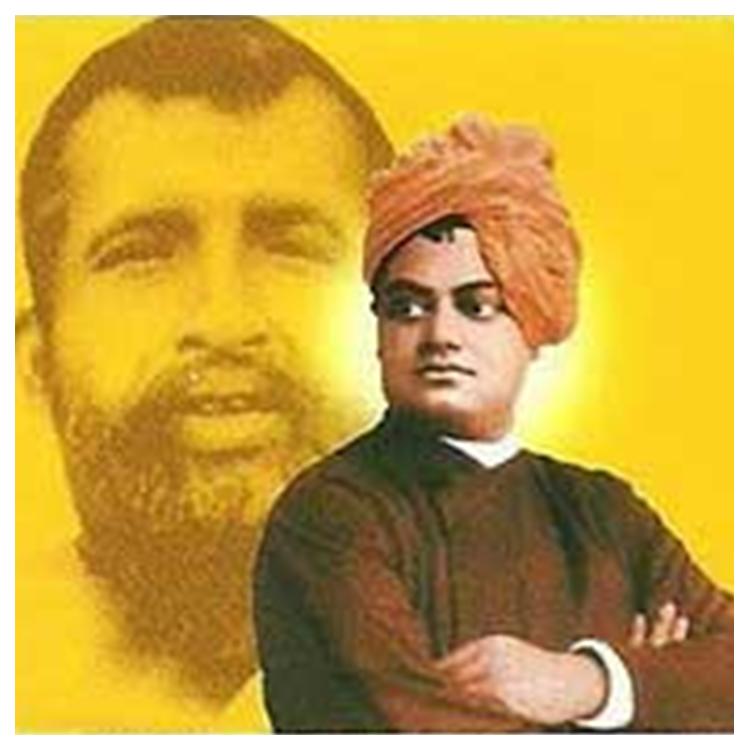
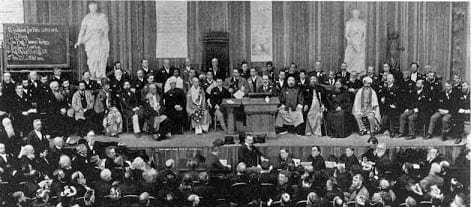

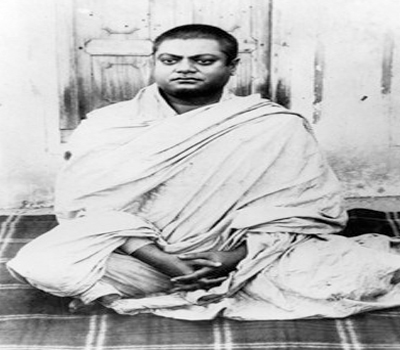
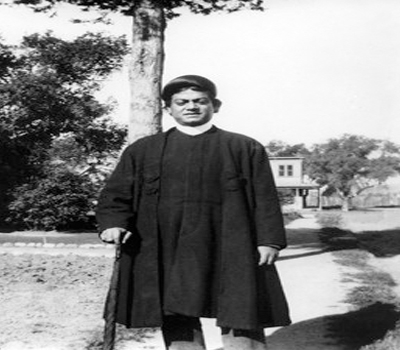
Leave A Comment